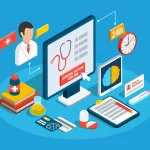
SRS for Hospital Management Systems
In today’s healthcare environment, the efficiency, and reliability of hospital management systems are important. Crafting a well-defined Software Requirement Specification (SRS) for hospital management systems ensures that these solutions meet all necessary standards and functionality.
This article explores the essential components, benefits, and steps in developing a comprehensive SRS for hospital management systems. The SRS for hospital management systems is a critical document that outlines the requirements and functionalities of the system.
This specification is a roadmap for developers, stakeholders, and end-users, ensuring that the final product meets all operational and regulatory needs. By detailing every aspect of the system, from user interface design to backend processes, an effective SRS helps avoid costly errors and project delays.
Importance Of SRS For Hospital Management System
A strong SRS for the hospital management system plays a vital role in the development process. It acts as a contract between the stakeholders and the development team, clearly defining expectations and deliverables. The SRS helps in:
- Ensuring all requirements are met
- Providing a clear roadmap for developers
- Reducing misunderstandings and miscommunications
- Facilitating accurate project estimation and planning
- Serving as a reference for validation and verification
Components of an SRS for Hospital Management System
An SRS document for a hospital management system typically includes several key sections:
1. System Overview
The system overview provides a high-level description of the hospital management system, including its purpose, scope, and objectives. This section sets the stage for the detailed requirements that follow.
2. Functional Requirements
The functional requirements of HMS specify what the system should do. For a hospital management system, these may include:
- Patient Registration: Allowing patients to register and update their information.
- Appointment Scheduling: Enabling patients and staff to schedule and manage appointments.
- Billing and Invoicing: Managing billing processes, insurance claims, and payments.
- Medical Records Management: Storing and retrieving patient medical records securely.
- Inventory Management: Tracking medical supplies and equipment.
3. Non-Functional Requirements
Non-functional requirements define how the system performs its functions. These include:
- Performance: The system should handle a specified number of transactions per second.
- Security: Ensuring patient data is protected and complies with regulations like HIPAA.
- Usability: The system should be user-friendly and accessible to all users.
- Reliability: The system should operate without failures and ensure data integrity.
- Scalability: The system should accommodate future growth and additional functionalities.
4. User Interfaces
This section describes the design and layout of the user interfaces. It includes mockups and wireframes to give a visual representation of the system.
5. System Architecture
The system architecture outlines the overall structure of the hospital management system, including hardware and software components, network architecture, and data flow diagrams.
6. Data Requirements
Data requirements detail the types and formats of data that the system will handle. This includes patient information, medical records, billing details, and more.
7. External Interface Requirements
These requirements specify how the system will interact with other systems, such as laboratory information systems, pharmacy management systems, and external databases.
8. System Constraints
identify any limitations or restrictions that affect the system’s design and implementation. This could include hardware limitations, regulatory requirements, or budget constraints.
LazyMonkey’s real-time patient feedback system helps hospitals meet standards and improve care quality.
Developing an SRS for Hospital Management System
Creating a comprehensive SRS involves several steps:
1. Requirement Gathering
is the first step in developing an SRS. This involves collecting information from various stakeholders, including healthcare professionals, administrative staff, and patients. Techniques such as interviews, surveys, and observation can be used to gather requirements.
2. Requirement Analysis
Once the requirements are gathered, they need to be analyzed to ensure they are feasible and align with the project’s goals. This step involves prioritizing requirements, resolving conflicts, and identifying any gaps.
3. Requirement Specification
The specification phase involves documenting the requirements clearly and concisely. This includes defining functional and non-functional requirements, user interfaces, data requirements, and system constraints.
4. Requirement Validation
ensures that the documented requirements accurately reflect the needs of the stakeholders. This can be done through reviews, inspections, and walkthroughs.
5. Requirement Management
Requirement management is an ongoing process that involves tracking and managing changes to the requirements throughout the project lifecycle. This ensures that the system remains aligned with the stakeholders’ needs.
Challenges in Developing an SRS for Hospital Management System
Developing an SRS for a hospital management system can be challenging due to several factors:
1. Complexity of Healthcare Processes
Are inherently complex and involve numerous stakeholders with different needs and expectations. Capturing all these requirements accurately can be difficult.
2. Regulatory Compliance
Hospital management systems must comply with various regulations, such as HIPAA in the United States. Ensuring that the system meets all regulatory requirements adds an extra layer of complexity to the SRS.
3. Integration with Existing Systems
Many hospitals already have existing systems in place. Integrating a new hospital management system with these legacy systems can be challenging and requires careful planning and execution.
4. User Acceptance
Ensuring that the end-users accept and effectively use the new system is crucial for its success. This involves designing a user-friendly interface and providing adequate training and support.
Benefits of a Well-Defined SRS for Hospital Management System
A well-defined SRS for a hospital management system offers numerous benefits:
1. Improved Communication
An SRS serves as a communication tool between stakeholders and the development team. It ensures that everyone has a clear understanding of the project’s goals and requirements.
2. Enhanced Project Management
A detailed SRS helps in accurate project estimation and planning. It provides a clear roadmap for the development team, reducing the risk of project delays and cost overruns.
3. Better Quality Assurance
An SRS provides a reference for validation and verification. It ensures that the final product meets all specified requirements and performs as expected.
4. Reduced Risk of Scope Creep
By clearly defining the project’s scope and requirements, an SRS helps in managing changes and reducing the risk of scope creep.
5. Higher User Satisfaction
A well-defined SRS ensures that the final product meets the needs and expectations of the end-users. This leads to higher user satisfaction and acceptance.
Click here to know more about benefits of hospital management system.
Conclusion
In conclusion, a comprehensive SRS for hospital management systems is essential for ensuring that the final product meets all operational and regulatory needs. By clearly defining the requirements and functionalities, an SRS helps in accurate project planning, reduces the risk of errors and delays, and enhances the system’s overall quality.
Developing a detailed SRS involves several steps, including requirement gathering, analysis, specification, validation, and management. Despite the challenges, the benefits of a well-defined SRS are significant, leading to improved communication, better project management, and higher user satisfaction.
Frequently Asked Questions?
Why Is An SRS Important For Hospital Management Systems?
An SRS is important because it ensures all requirements are met, provides a clear roadmap for developers, reduces misunderstandings, facilitates accurate project estimation and planning, and serves as a reference for validation and verification
What Are The Components Of An SRS For Hospital Management Systems?
The components of an SRS for hospital management systems include functional requirements, non-functional requirements, system overview, user interfaces, system architecture, data requirements, external interface requirements, and system constraints.
What Challenges Are Involved In Developing An SRS For Hospital Management Systems?
Challenges include the complexity of healthcare processes, regulatory compliance, integration with existing systems, and ensuring user acceptance.
Enhance Patient Care and NABH Compliance with LazyMonkey
LazyMonkey is your all-in-one solution for improving patient care, retaining more patients, and meeting NABH standards. Our powerful QR-based feedback tool enables you to capture real-time insights from patient feedback, discharge surveys, staff and doctor evaluations, and clinical research, while also streamlining inter-departmental communication.
Transform your healthcare facility today - reach out to us at hello@lazymonkey.in, or request a demo here!
Elevate Your Restaurant Experience with LazyMonkey
LazyMonkey’s QR-based feedback system helps you gather real-time insights from customers, track satisfaction levels, and enhance the dining experience. Get instant feedback on your menu, service, and ambience, and make data-driven improvements to boost repeat customers and reviews.
Improve your restaurant today – reach out to us at hello@lazymonkey.in, or request a demo here!
Empower Student Engagement and Campus Improvement with LazyMonkey
LazyMonkey offers a seamless way to gather student feedback, track satisfaction, and enhance campus life. From course evaluations to dorm feedback, our QR-based solution makes it easy to capture valuable insights and improve student retention.
Upgrade your university experience – contact us at hello@lazymonkey.in, or request a demo here!
Streamline Feedback and Drive Performance Across Your Enterprise/Franchise with LazyMonkey
Whether you manage one or multiple locations, LazyMonkey’s QR-based feedback system helps you gather real-time employee and customer feedback. Improve operational efficiency, track satisfaction, and make data-driven decisions to enhance brand consistency and growth.
Transform your franchise today – reach out to us at hello@lazymonkey.in, or request a demo here!
Enhance Customer Satisfaction and Service Standards in Banking with LazyMonkey
LazyMonkey empowers banks to capture real-time feedback from clients across branches. Improve customer experience, assess service quality, and ensure regulatory compliance with our QR-based solution, helping you retain clients and meet banking standards.
Elevate your bank’s customer care – contact us at hello@lazymonkey.in, or request a demo here!
Boost Customer Engagement and Mall Satisfaction with LazyMonkey
LazyMonkey’s QR-based feedback tool enables you to collect feedback from shoppers, track satisfaction, and enhance the mall experience. Gather insights on store services, cleanliness, and entertainment to create an unmatched customer journey.













